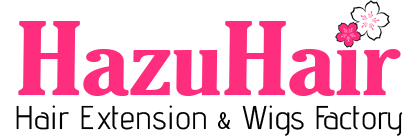Hair knowledge
What Are The Pros and Cons of Weft Hair Extensions?
Long, luscious hair is often the dream of many women, as it symbolizes beauty, femininity, and elegance. Achieving such hair can seem like a challenge, especially if you have naturally shorter or thinner locks. However, one of the fastest and most effective ways to add length and volume to your hair is by using hair extensions.
With the growing demand for hair extensions and hairpieces for both beauty and convenience, there are now numerous types available on the market. This wide variety of options can often leave you feeling overwhelmed, unsure of which one to choose. To help simplify things, we can break down hair extensions into three main categories based on their installation methods: weft, strand-by-strand, and clip-in extensions. Each of these types has its own benefits, techniques, and style options.
In this article, we’ll focus specifically on weft hair extensions, providing you with a comprehensive overview of this popular choice, so you can make an informed decision before selecting the right extension type for your hair.
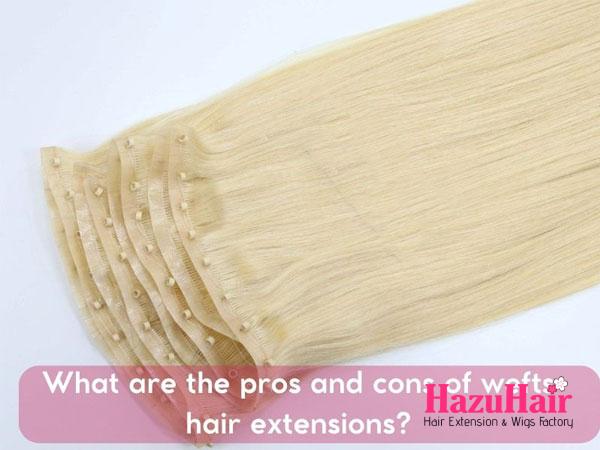
What Is Weft Extensions?
Weft extensions, often referred to as weaves, are a popular choice for adding length, volume, and texture to natural hair. The term “weft” refers to the process of sewing or weaving hair strands together to create a continuous, long piece of hair, typically 2 to 4 inches wide. This weft of hair can then be attached to the natural hair in rows using various application methods. The two most common techniques for applying weft extensions are the tape-in method and the sew-in or weave method.
In the tape-in method, the wefts are pre-taped with adhesive, allowing them to be securely attached to small sections of natural hair. This method is popular due to its relatively quick application and ability to add volume and length without the need for braiding or sewing.
On the other hand, the sew-in or weave method involves braiding the natural hair into small, tight braids, and then sewing the wefts onto these braids using a needle and thread. This method is favored by many for its durability and ability to create a seamless, natural look. Both methods of applying weft extensions offer flexibility in terms of styling and customization, allowing users to choose the right look that fits their personal preferences.
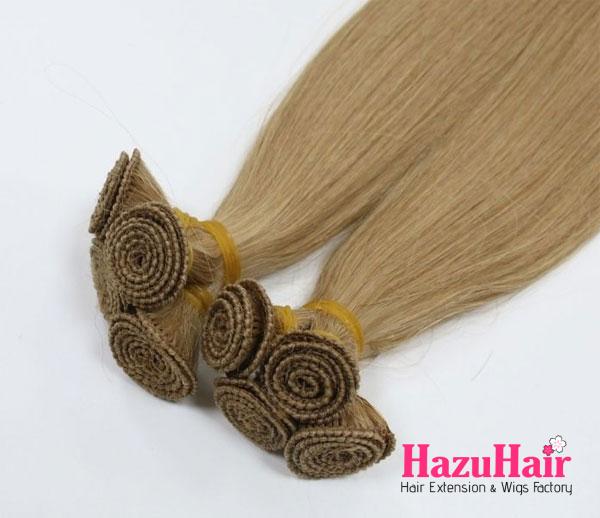
The Growing Popularity of Weft Hair Extensions
The demand for weft hair extensions has significantly increased in recent years, thanks to their ability to provide a versatile and natural-looking hair transformation. These extensions make it easy to achieve the perfect length, volume, and texture without the need for complex styling or permanent changes. As more people turn to wefts for a quick and effective hair upgrade, it’s important to consider the various types available, along with their benefits and potential drawbacks.
Whether you’re looking to transform your style in an instant or gradually enhance your hair over time, weft extensions have become a popular choice for anyone aiming to improve their hair appearance. With their growing popularity, it’s clear that weft extensions offer an easy and stylish solution for anyone seeking to enhance their locks. Dive into the reasons behind their increasing demand and discover how they can help you achieve the hair of your dreams.
Pros and Cons of Weft Hair Extensions
Weft hair extensions, particularly the sew-in or weave method, are well-suited for individuals with thick, coarse, or curly hair. This technique involves creating horizontal cornrows in your natural hair, into which the weft hair extensions are sewn. The extensions are literally “woven” through the braids, creating a secure and natural-looking result.
This method is especially popular among African women, as their naturally thick hair helps conceal the braids, resulting in a seamless, full appearance. While weft extensions can provide added length and volume, it’s important to consider the potential downsides, such as the time required for installation and maintenance, as well as the risk of tension on the scalp if not done correctly.
Pros:
- Ideal for individuals with thick hair, as it blends well and adds volume.
- The application process doesn’t require heat or glue, reducing the risk of damage to your natural hair.
- A fast and effective solution for adding length and volume, making it a great option for those with shorter hair.
- Sew-in installation ensures there are no visible gaps, creating a seamless, natural look.
- Once installed, the extensions stay in place, with no slipping unless the braids loosen. You can still use oil or silicone-based products without worrying about them slipping.
- With proper care and maintenance, weave extensions can last up to 2-3 months.
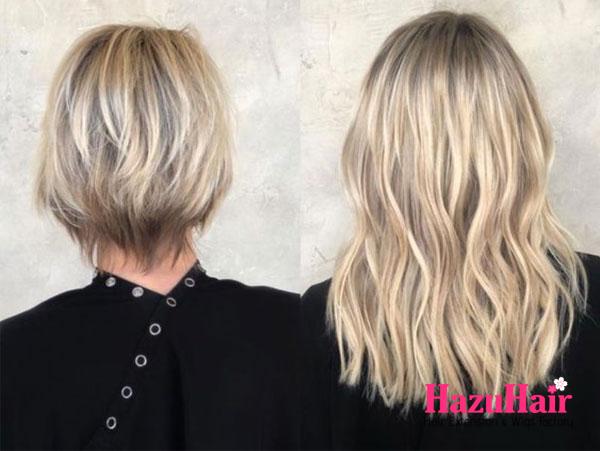
Cons:
- The application process can be time-consuming, often taking several hours, so it’s wise to prepare some snacks for the wait.
- The extensions may cause tension on your scalp, leading to discomfort or even traction alopecia and headaches.
- Regular washing is essential to maintain cleanliness; otherwise, build-up can lead to scalp irritation or infection.
- Styling options may be limited, as the cornrows may be visible, restricting certain looks.
Maintenance
Before washing or going to bed, gently detangle your hair to prevent unnecessary tension. Be careful not to pull too close to the joint to avoid loosening the extensions.
Wash your hair 1-2 times a week with a mild shampoo, taking care not to disturb the sewn area. You can gently massage your scalp with circular motions while shampooing to cleanse effectively.
When conditioning your hair, apply the product from just below the joints, avoiding the area where the extensions meet your natural hair. Using too much conditioner near the attachment points can cause the extensions to loosen and fall out.
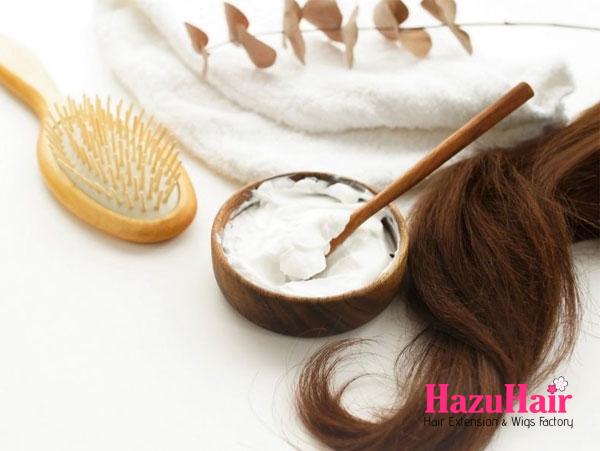
Pros and Cons of Hand-Tied Extensions
Hand-tied extensions are favored for their natural appearance and lightweight feel, but like any hair extension method, they come with both advantages and challenges. Here’s a breakdown of the pros and cons to help you make an informed decision:
Pros:
- Natural Appearance: Hand-tied extensions are renowned for seamlessly blending with natural hair, offering a very realistic look.
- Flexible: The lightweight wefts and flexible installation ensure that these extensions feel comfortable and don’t put strain on your scalp.
- Versatility: These extensions offer a wide range of styling possibilities, from updos to braids, allowing you to experiment with various looks.
- Minimal Damage: Since the installation doesn’t require heat or adhesives, it’s a less damaging method for your natural hair, provided the process is done properly.
- Long Lifespan: With proper care, hand-tied extensions can last for several months, making them a cost-effective option over time.
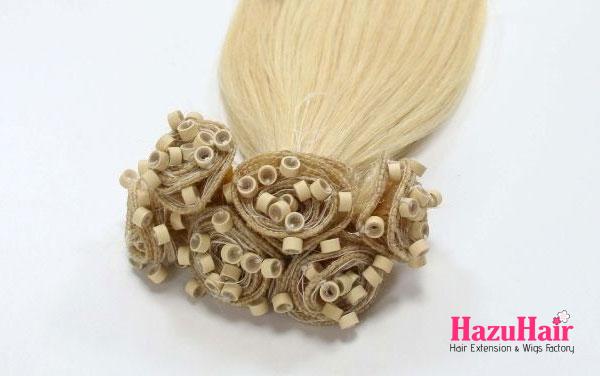
Cons:
- Time-Consuming Application: The hand-tied installation process can be lengthy, often taking several hours at the salon to complete.
- Regular Maintenance: These extensions require ongoing maintenance to avoid tangling and matting due to their natural integration with your hair.
- Skill-Dependent: Successful hand-tied extension installation relies heavily on the expertise of a trained stylist, so finding a qualified professional is crucial.
- Higher Cost: Because the process requires specialized skills, hand-tied extensions tend to be more expensive than other methods.
- Blending Challenges: While they blend well with most hair types, those with very short or thick hair may find it harder to achieve a smooth, seamless look.
Before choosing hand-tied extensions, it’s important to consider your lifestyle, hair type, and how much time you’re willing to dedicate to maintenance. A consultation with a skilled stylist can help determine whether this technique is right for you and your hair goals.
Micro Weft Hair Extensions: Pros and Cons
Micro weft hair extensions are a popular option for women who want to achieve a stylish, everyday look. However, before diving into micro weft hair extensions reviews, it’s important to understand both their advantages and drawbacks. While micro weft extensions offer many benefits, they do come with some challenges.
The Pros:
- Safe for Natural Hair: Micro weft extensions are completely safe for your natural hair since they do not involve any adhesive or bonding agents.
- Easy to Adjust and Remove: These extensions are simple to adjust, and they can be easily removed by a professional stylist without causing damage to your hair.
- Natural Look: The micro weft method creates a bouncy, natural appearance that seamlessly blends with your own hair.
- Long-Lasting: With proper care, micro weft extensions can last up to 6 months or longer, offering durability compared to other extension methods.
- Quick Installation: The installation process can be completed in as little as an hour by a skilled stylist.
- Recyclable and Versatile: These extensions are reusable, making them an eco-friendly option. They are also flexible when it comes to styling, allowing for a wide variety of looks.
- Gentle on Hair: The connectors used in micro weft extensions are designed to be gentle on your natural hair, reducing the risk of damage.
- Coloring Options: You can color your hair without worrying about damaging the bonds holding the extensions in place.
- Styling Freedom: Just like your natural hair, you can curl, straighten, or style your micro weft extensions in any way you like. Be sure to use a heat protectant to avoid damage.
- Affordable: Micro weft extensions are generally less expensive than other types of hair extensions, making them a cost-effective option.
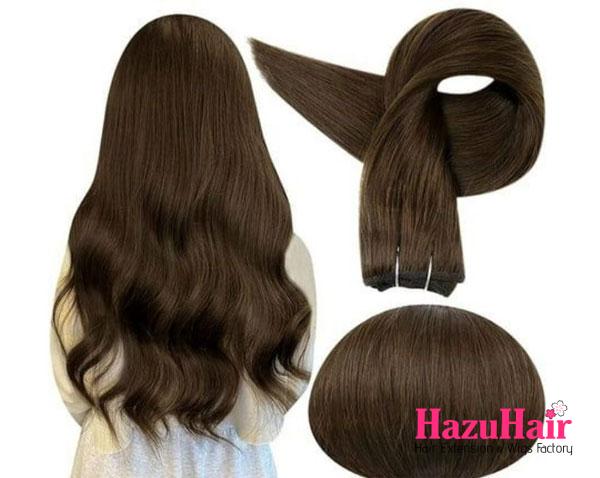
The Cons:
- Not Suitable for Damaged Hair: If your natural hair is damaged, micro weft extensions may not be the best choice, as they can exacerbate existing issues.
- Lengthy Installation Time: The installation of micro weft extensions can take up to three hours, making it one of the more time-consuming extension methods.
- Potential Discomfort: Some users may experience headaches or scalp soreness after the extensions are applied, which can last for several days.
- Not Ideal for Thin Hair: If you have thin or fine hair, micro weft extensions may cause breakage and shedding, which can ultimately lead to further hair damage.
When considering micro weft hair extensions, weigh the pros and cons to determine if this method is right for your hair type and lifestyle.
Above are the two main methods of applying weft hair extensions. Consider the pros and cons of each, and choose the one that best suits your needs.
Don’t forget to subscribe for more tips and updates from HazuHair. Thank you for reading!
and…
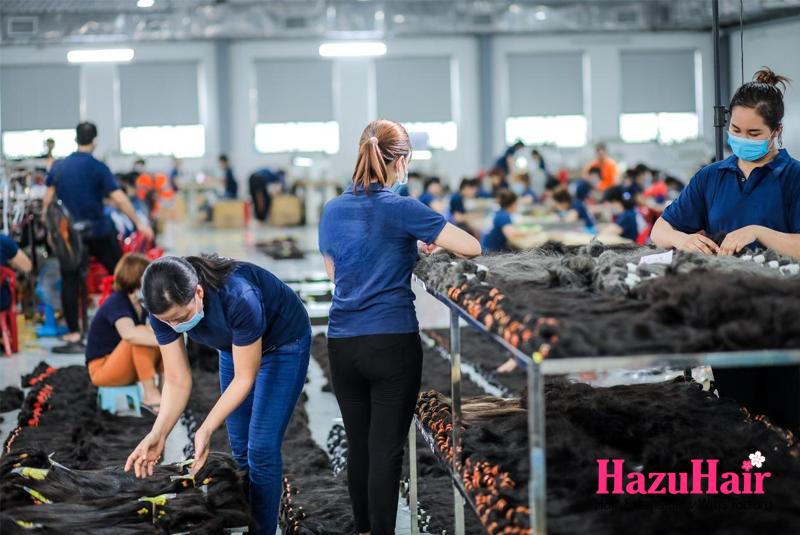
If you’re looking to buy high-quality wigs or hair extensions, look no further than HazuHair.
We are a trusted Vietnamese hair factory with over 100 skilled workers, offering a wide range of hair styles including wavy, curly, straight, kinky, and more.
Our products come in various colors such as natural black, ombre, blonde, red, pink, and many others.
Reach out to us today!
- Hair Factory: Tan Son 2 Village, Tan Dinh, Lang Giang, Bac Giang Province, Vietnam
- Hotline: +849 4949 3883
- Whatsapp Mrs ThanhLam: https://wa.me/84949493883
- Website: https://hazuhair.com
